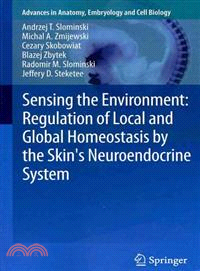Sensing the Environment
商品資訊
系列名:Advances in Anatomy, Embryology and Cell Biology
ISBN13:9783642196829
出版社:Springer Verlag
作者:Andrzej T. Slominski; Michal A. Zmijewski; Cezary Skobowiat; Blazej Zbytek; Radomir M. Slominski
出版日:2012/06/02
裝訂/頁數:平裝/115頁
規格:22.9cm*15.2cm*0.6cm (高/寬/厚)
版次:1
商品簡介
The skin, the body’s largest organ, is strategically located at the interface with the external environment where it detects, integrates and responds to a diverse range of stressors, including solar radiation. It has already been established that the skin is an important peripheral neuroendocrine-immune organ that is closely networked with central regulatory systems. These capabilities contribute to the maintenance of peripheral homeostasis. Specifically, epidermal and dermal cells produce and respond to classical stress neurotransmitters, neuropeptides and hormones, production which is stimulated by ultraviolet radiation (UVR), biological factors (infectious and non-infectious) and other physical and chemical agents. Examples of local biologically active products are cytokines, biogenic amines (catecholamines, histamine, serotonin and N-acetyl-serotonin), melatonin, acetylocholine, neuropeptides including pituitary (proopiomelanocortin-derived ACTH, b-endorphin or MSH peptides, thyroid stimulating hormone) and hypothalamic (corticotropin-releasing factor and related urocortins, thyroid-releasing hormone) hormones, as well as enkephalins and dynorphins, thyroid hormones, steroids (glucocorticoids, mineralocorticoids, sex hormones, 7-d steroids), secosteroids, opioids and endocannabinoids. The production of these molecules is hierarchical, organized along the algorithms of classical neuroendocrine axes such as the hypothalamic pituitary adrenal axis (HPA), hypothalamic-thyroid axis (HPT), serotoninergic, melatoninergic, catecholaminergic, cholinergic, steroid/secosteroidogenic, opioid and endocannabinoid systems. Disruptions of these axes or of communication between them may lead to skin and/or systemic diseases. These local neuroendocrine networks also serve to limit the effect of noxious environmental agents to preserve local and consequently global homeostasis. Moreover, the skin-derived factors/systems can also activate cutaneous nerve endings to alert the brain to changes in the epidermal or dermal environments, or alternatively to activate other coordinating centers by direct (spinal cord) neurotransmission without brain involvement. Furthermore, rapid and reciprocal communications between epidermal and dermal and adnexal compartments are also mediated by neurotransmission including antidromic modes of conduction. Lastly, skin cells and the skin as an organ coordinate and/or regulate not only peripheral but also global homeostasis.
主題書展
更多書展今日66折
您曾經瀏覽過的商品
購物須知
外文書商品之書封,為出版社提供之樣本。實際出貨商品,以出版社所提供之現有版本為主。部份書籍,因出版社供應狀況特殊,匯率將依實際狀況做調整。
無庫存之商品,在您完成訂單程序之後,將以空運的方式為你下單調貨。為了縮短等待的時間,建議您將外文書與其他商品分開下單,以獲得最快的取貨速度,平均調貨時間為1~2個月。
為了保護您的權益,「三民網路書店」提供會員七日商品鑑賞期(收到商品為起始日)。
若要辦理退貨,請在商品鑑賞期內寄回,且商品必須是全新狀態與完整包裝(商品、附件、發票、隨貨贈品等)否則恕不接受退貨。
























